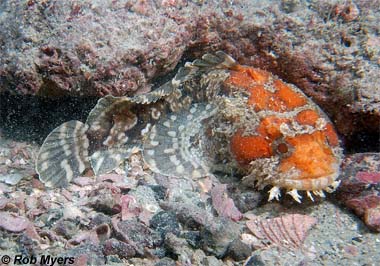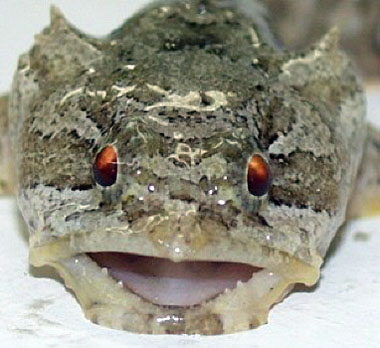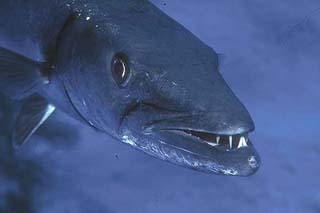Gulf Toadfish

Opsanus beta
This sluggish brown fish prefers hiding in sand or seaweed, but it can survive for some time out of the water, or in poorly oxygenated water. It’s named because it produces a toad-like grunt and whistle to attract a mate. As with some other fish species, it is the male toadfish that guards the eggs until they hatch.
Order – Batrachoidiformes
Family – Batrachoididae
Genus – Opsanus
Species – beta
Common Names
English language common names of this fish include gulf toadfish, dogfish, mudfish, and oysterdog. Other common names are lahtikonnakala (Finnish), Mexikansk paddefisk (Danish), rozpusznik swiszczacy (Polish) and sapo de boca blanca (Spanish).
Importance to Humans
Toadfishes, such as the gulf toadfish, are sometimes marketed fresh or live for human consumption, such as in Chinatown (New York City), but are generally considered undesirable and so are not targeted in any fishery. This fish is not considered a gamefish.
The gulf toadfish is considered to be of poor quality, and have been linked to ciguatera poisoning in humans.
Conservation
This species is common to abundant in areas where it occurs, and there is no indication for the need of conservation efforts. Due to the lack of directed fisheries for the gulf toadfish, there are no regulations regarding the capture of this species.
The gulf toadfish is not listed as endangered or vulnerable with the International Union for Conservation of Nature and Natural Resources (IUCN). The IUCN is a global union of states, governmental agencies, and non-governmental organizations in a partnership that assesses the conservation status of species.
> Check the status of the gulf toadfish at the IUCN website.
Geographical Distribution

The gulf toadfish occurs in the western Atlantic Ocean, from southeastern Florida (U.S.), east to the Bahamas, southeast through the entire Gulf of Mexico to Yucatan, Mexico. It has not been recorded in the Caribbean Sea.
Habitat
Seagrass beds and sandy and rock rubble bottoms located in bays, lagoons, and shallows coastal areas provide habitats for the solitary gulf toadfish. This bottom-dwelling, sluggish fish occurs as deep as 820 feet (250 m). It buries itself in sand or hides among seaweeds, darting out to capture prey. A hardy fish, the gulf toadfish can remain alive for an extended period of time out of water as well as being able to survive in waters containing low levels of dissolved oxygen. As its common name suggests, it is capable of producing audible sounds, using its swim bladder, which are reminiscent of vocals produced by some toads. This is often followed by a whistle sound, similar to that of a boat whistle, that is short and high-pitched.
Biology

Distinctive Features
The gulf toadfish lacks scales and has three lateral lines. The head is large, broad, and flattened, with a lower jaw projecting beyond upper jaw. Fleshy tabs are located along the lower jaw with a blunt maxillary barbel. Tentacles are located along the inner margin of the eye. The mouth is wide and contains numerous sharp teeth. The large pectoral fins are fan-like, posterior to the pelvic fins. The small pelvic fins are located forward, under the chin. The gulf toadfish has small pelvic fins located forward on the body, while both the anal fin and the second dorsal fin are elongate. Males have specialized swim bladder muscles that are used to produce mating calls.
Coloration
The head and body are brown to gray with brown, tan, and white mottling. The darkest, more uniform-colored areas are on the head and forebody of the fish. Pale areas along the body form rosettes toward the posterior end of the gulf toadfish. Brown diagonal bands are located on the dorsal and anal fins and vertical bars exist on the pectoral and caudal fins. The inside of the mouth is pale or white.
Size, Age, and Growth
The gulf toadfish reaches a maximum length of 12.8 inches (32.4 cm) in standard length, mature males reaching a larger size than females.
Dentition
Narrow bands of blunt teeth are located along the jaw, vomer, and palatine. Canine teeth are absent in the jaw. Males have large posterior premaxillary teeth that are directed forward, while females have smaller premaxillary teeth that are not directed forward.
Food Habits
Prey items of this voracious carnivore include small fishes such as gobies, crustaceans (shrimps and crabs), annelids, and mollusks.
Reproduction
The gulf toadfish spawns on the western coast of Florida during February and March when water temperatures reach approximately 67°F (19.5°C). Territorial males establish nests in shells and sponges. Females prefer protective nest sites with one opening than those that are more with multiple openings. Males occupying nests in close proximity to other males appear to be more successful than solitary nesting males. Males attract females with long calls (up to 15 minutes) of toad-like sounds produced by the swim bladder. After spawning occurs, the male guards and aerates the large eggs until they hatch.

Predators
Barracuda are known to feed on the gulf toadfish. Other large fishes, marine mammals such as dolphin, and sea turtles are potential predators of the gulf toadfish.Parasites
Oocysts of the protozoan Calyptospora funduli have been found in the liver of a gulf toadfish.
Taxonomy
The gulf toadfish was originally named Batrachus tau beta by well-known deep sea ichthyologists G. Brown Goode and Tarleton H. Bean in 1880. It is currently recognized as Opsanus beta (Goode & Bean 1880), the scientifically valid name in use today. A synonym that sometimes used to refer to this fish is Opsanus vandeuseni Fowler, 1939.
Prepared by: Cathleen Bester